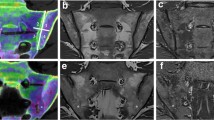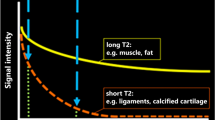Abstract
Background
Optimized MRI parameters can be leveraged to improve signal intensity, accelerate imaging acquisition and increase resolution. Higher-resolution imaging with a small field of view (FOV) has been proposed as standard practice for investigating sacroiliac (SI) joints, but the improvement in disease detection and characterization over pelvic imaging with large FOV has not been established.
Objective
The purpose of this study was to compare dedicated MR images of the SI joints with survey imaging (large-FOV pelvic MRI) for detecting sacroiliitis.
Materials and methods
Fifty-eight pediatric patients suspected of having sacroiliitis underwent dedicated sacroiliac joint and survey pelvic imaging at the same imaging session. We independently evaluated the small- and large-FOV image data sets for presence or absence of sacroiliitis, e.g., bone marrow edema, erosions and synovitis. We used nonparametric statistical tests to compare lesion scores for severity of inflammation. We created test characteristics for the survey pelvic images (low-resolution images of the sacroiliac joints) using dedicated sacroiliac images (small-FOV, high-resolution images) as the gold standard.
Results
Dedicated sacroiliac small-FOV MRI detected more sacroiliitis compared to survey pelvic imaging with large FOV (χ2=6.125, P=0.013). Readers detected significantly more features of inflammation on small- compared to large-FOV images, e.g., erosions (P=0.039), synovitis (P=0.009), sclerosis (P=0.017) and osteitis (P=0.001). Test characteristics for pelvic large-FOV imaging were sensitivity=0.76, specificity=1.00, positive predictive value = 1.00 and negative predictive value = 0.75.
Conclusion
This study provides test characteristics for survey pelvic MRI with lower-resolution large-field-of-view images as a screening tool for detecting sacroiliitis. Pelvic screening studies with large FOV have lower sensitivity, and dedicated sacroiliac MRI with small FOV is superior in detecting sacroiliitis when compared to pelvic screening MRI.




Similar content being viewed by others
References
Sieper J, Rudwaleit M, Baraliakos X et al (2009) The Assessment of SpondyloArthritis international society (ASAS) handbook: a guide to assess spondyloarthritis. Ann Rheum Dis 68(Suppl 2):ii1–i44
Puhakka KB, Jurik AG, Schiottz-Christensen B et al (2004) Magnetic resonance imaging of sacroiliitis in early seronegative spondylarthropathy. Abnormalities correlated to clinical and laboratory findings. Rheumeatology 43:234–237
Maksymowych WP (2012) Controversies in conventional radiography in spondyloarthritis. Best Pract Res Clin Rheumatol 26:839–852
Bredella MA, Steinbach LS, Morgan S et al (2006) MRI of the sacroiliac joints in patients with moderate to severe ankylosing spondylitis. AJR Am J Roentgenol 187:1420–1426
Munir S, Patil K, Miller E et al (2014) Juvenile idiopathic arthritis of the axial joints: a systematic review of the diagnostic accuracy and predictive value of conventional MRI. AJR Am J Roentgenol 202:199–210
Forst SL, Wheeler MT, Fortin JD, Vilensky JA (2006) The sacroiliac joint: anatomy, physiology and clinical significance. Pain Physician 9:61–67
Hermann K-GA, Bollow M (2014) Magnetic resonance imaging of sacroiliitis in patients with spondyloarthritis: correlation with anatomy and histology. Rofo 186:230–237
Antonio GE, Griffith JF, Yeung DKW (2004) Small-field-of-view MRI of the knee and ankle. AJR Am J Roentgenol 183:24–28
Griffith JF, Wang Y-XJ, Lodge SJ et al (2010) Small field-of-view surface coil MR imaging of talar osteochondral lesions. Foot Ankle Int 31:517–522
Toomayan GA, Russell Holman W, Major NM et al (2006) Sensitivity of MR arthrography in the evaluation of acetabular labral tears. AJR Am J Roentgenol 186:449–453
de Hooge M, van den Berg R, Navarro-Compán V et al (2013) Magnetic resonance imaging of the sacroiliac joints in the early detection of spondyloarthritis: no added value of gadolinium compared with short tau inversion recovery sequence. Rheumatology 52:1220–1224
Puhakka KB, Melsen F, Jurik AG et al (2004) MR imaging of the normal sacroiliac joint with correlation to histology. Skelet Radiol 33:15–28
Rudwaleit M, Jurik AG, Hermann KG et al (2009) Defining active sacroiliitis on magnetic resonance imaging (MRI) for classification of axial spondyloarthritis: a consensual approach by the ASAS/OMERACT MRI group. Ann Rheum Dis 68:1520–1527
Martin Bland J, Altman D (1986) Statistical methods for assessing agreement between two methods of clinical measurement. Lancet 327:307–310
Author information
Authors and Affiliations
Corresponding author
Ethics declarations
Conflicts of interest
None
Additional information
Publisher’s note
Springer Nature remains neutral with regard to jurisdictional claims in published maps and institutional affiliations.
Rights and permissions
About this article
Cite this article
Wagle, S., Gu, J.T., Courtier, J.L. et al. Value of dedicated small-field-of-view sacroiliac versus large-field-of-view pelvic magnetic resonance imaging for evaluating pediatric sacroiliitis. Pediatr Radiol 49, 933–940 (2019). https://doi.org/10.1007/s00247-018-4323-5
Received:
Revised:
Accepted:
Published:
Issue Date:
DOI: https://doi.org/10.1007/s00247-018-4323-5




